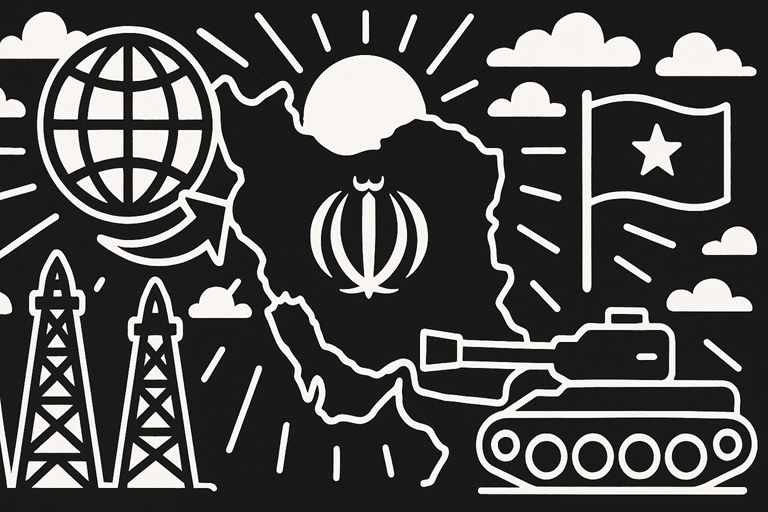On Iran and Trump
Now, Iran has become a major focus, especially after former U.S. President Donald Trump threatened to bomb the country if it didn’t limit its nuclear program. This warning angered Iranian leaders and highlighted the complicated mix of power, resources, and strategy that shapes Iran’s position in the world.
Iran Matters for Its Key Location
Iran’s importance comes from its location in the Middle East, where it borders seven countries and controls access to key waterways. One of the most crucial is the Strait of Hormuz, a narrow passage where 21 million barrels of oil per day flowed in 2022—about 21% of the world’s oil consumption. Any disruption here could cause major problems in global energy markets, giving Iran strong economic leverage.
But Iran’s power goes beyond geography. It also influences the region by supporting armed groups, known as the Iran Threat Network (ITN). This network includes tens of thousands of fighters, such as Hezbollah in Lebanon and the Houthis in Yemen, allowing Iran to extend its reach into the Middle East, South Asia, Africa, and Latin America. These groups help Iran in several ways: they act as military forces, deter enemies like Israel and Saudi Arabia, support allies like Syria, and spread Iran’s influence. As the leading Shiite Muslim country, Iran also plays a big role in religious conflicts, often competing with Sunni-led nations for power in the region.
Iran’s Economic Importance: Rich in Energy but Facing Challenges
Iran’s economy is heavily influenced by its huge reserves of oil and natural gas. It has the fourth-largest proven oil reserves in the world, holding about 208.6 billion barrels, and the second-largest natural gas reserves, with 1,200 trillion cubic feet. This makes Iran a key player in the global energy market.
Even though international sanctions have made it harder for Iran to sell its oil, the country still manages to be a major supplier—especially to China, which has increased its oil imports from Iran in recent years. However, Iran’s economy, which was valued at $401.50 billion in 2023, remains unstable because it depends too much on oil revenue. External factors, such as fluctuating oil prices and political tensions, also make the economy vulnerable to sudden downturns.
Iran also has the potential to become an important trade hub between different regions. Large-scale projects, like the International North-South Transport Corridor (INSTC)—which connects India to Russia through Iran—and its participation in China’s Belt and Road Initiative (BRI), could boost trade and investment in the country. However, because of ongoing sanctions, Iran has not been able to fully benefit from these opportunities. As a result, its economic growth has slowed, dropping from 5% in 2023 to around 2.7% in mid-2024. If restrictions ease in the future, Iran could play a bigger role in global trade, but for now, its economic progress remains limited.
Iran’s Military Strength and Nuclear Situation
Iran has a strong military, ranked 16th in the world with a PwrIndx score of 0.3048. It has 610,000 active soldiers and a reserve force of 350,000. One of its biggest strengths is its ballistic missile program, which is among the largest in the Middle East. Iran has also heavily invested in drones (UAVs) and cyber warfare, making its military more powerful and better at defending itself.
A key part of Iran’s military is the Islamic Revolutionary Guard Corps (IRGC), which has 190,000 personnel. The IRGC plays an important role in Iran’s defense, not just within its borders but also by supporting allied armed groups in other countries. This allows Iran to extend its influence without directly getting into wars.
Iran’s Nuclear Issue: A Global Concern
Iran’s nuclear program has been a source of tension for years. Former U.S. President Donald Trump’s threat to bomb Iran is similar to his decision in 2018, when the U.S. pulled out of the Iran nuclear deal (JCPOA). Iran is trying to balance its military strength with diplomacy. While it refuses direct negotiations under threats, it has shown willingness to talk indirectly through countries like Oman.
How Iran Prepares for Possible Conflicts
If a conflict were to break out—especially involving nuclear threats—Iran would rely on deterrence (the ability to strike back) and resilience (being able to withstand attacks).
While no country can fully protect itself from a nuclear attack, Iran has missiles capable of striking U.S. bases or Israel, which could serve as a warning to its enemies. Another key strategy Iran could use is closing the Strait of Hormuz, which would disrupt global oil supplies and put economic pressure on the world.
Iran’s alliances with Russia and China may provide political support, but it is unclear if these countries would offer military help in a direct conflict.
Iran’s Best Strategy is Avoiding the War
Instead of escalating tensions, Iran is likely to focus on reducing conflict while still maintaining its ability to defend itself. One approach is to engage in indirect diplomatic talks to ease sanctions, while at the same time keeping its military strong. To ensure its survival, Iran could spread out its leadership and military resources, making it harder for an enemy to wipe out its entire defense system in one strike. However, avoiding full-scale war should be its top priority, as a nuclear conflict would have devastating consequences for the entire world.
Iran’s Challenges at Home and Abroad
Inside the country, Iran faces serious economic problems. The economy has been struggling, with high inflation reaching 40.5% in July 2022 and unemployment staying above 10%. These issues have led to protests over rising fuel prices and demands for more political freedoms. Iran’s banking system is also in trouble, as many banks are weighed down by bad loans that they may never recover. At the same time, the private sector is weak, making it harder for businesses to grow and for people to find stable jobs. These economic struggles put pressure on the government, making it harder to maintain control.
On the international stage, sanctions have isolated Iran, limiting its ability to trade and access global financial markets. However, Iran has found ways around some restrictions, particularly by selling oil to China, one of its most important trade partners. Iran also works closely with Russia, especially in Syria, and has some potential opportunities to improve relations with European countries. However, its hostile relationships with the United States, Israel, and Gulf nations remain a major obstacle, shaping a complex and challenging diplomatic environment.
Iran’s Role in a Changing World
Iran’s strategic location, energy resources, and military strength make it an important player in global and regional affairs. However, it also faces serious economic struggles and international isolation. With tensions still high between Iran and the United States, the country’s future depends on how well it can balance diplomacy, military power, and internal reforms. How Iran handles these challenges will shape not just its own future but also the broader power dynamics in today’s world.
————
Rajeev Ahmed
The Editor of Geopolits.com and the Author of the book titled Bengal Nexus

